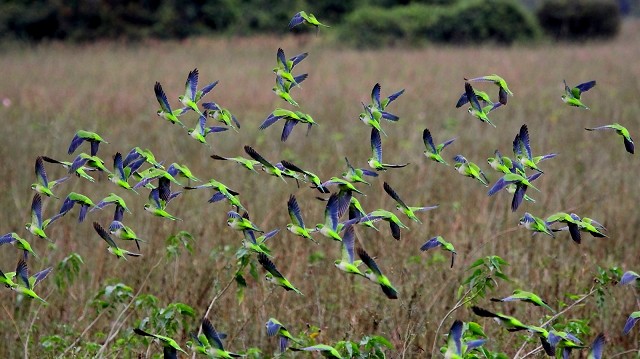A study of aggression in Monk Parakeets suggests that their positions in a pecking order are a function of the bird's perceptions of rank in their flock.
Newly formed groups of Monk Parakeets do not show evidence that they perceive rank, yet an awareness of it emerges quickly, when individuals direct aggression more frequently against those nearby in rank rather than with lower-ranked birds. But how do the birds know their rank and those in the rest of the flock?
"Parakeets appear to be able to connect the dots in their groups, remembering chains of aggression, so if A fights B, then watches how B fights C and how C fights D ... then A will use this knowledge to adjust how it interacts with E based on all of the fights in between," said a new study's lead author Elizabeth Hobson, published in the PLOS. The study sheds new light on how socially complex animal societies evolve and how dominance hierarchies are established.
A socially and cognitively complex species, Monk Parakeets inhabit a social structure organised by dominance hierarchies, in which each animal is ranked as dominant over animals below it and submissive to those above. Aggressive encounters usually drive rankings and, as might be expected, a higher rank often means better foraging and greater chances of reproductive success.
Unlike other animals that perhaps use visual cues such as size or perceptional clues such as spatial location, to determine rank, Monk Parakeets appear to rely on other clues — ones that are based on newly acquired social knowledge.

Monk Parakeets are very calculating in how they jostle for position in their hierarchies (Photo: Mathias)
In the study, Hobson and co-author Simon DeDeo analysed detailed observations of aggression in two independent groups of captive Monk Parakeets. Each group was observed over the course of 24 days.
"We looked for cases where we could clearly determine a winner when aggression took place — often these were cases where a bird approached another and knocked it off its perch. It's pretty easy to determine the winner in these kinds of events," Hobson said. A total of 1,013 wins in one group and 1,360 wins in the second group were analysed.
Mathematically sophisticated computation with this rich dataset then revealed that individuals accumulate knowledge of who against whom in fights, as they begin to interact and watch the fights of others. The birds then use this knowledge to refine their own behaviour by avoiding fights with birds higher-ranked than themselves, but also with birds that were much lower-ranked. Instead, they focused their aggression by choosing individuals with whom they might be closely matched. In effect, the aggression becomes more strategically directed.
Thus, the ability to determine rank among these socially precocious birds appears to be an act of cognitive complexity, learned through the bird's careful observation of how the other birds interact.
Hobson added: "Our approach provides insight not only into how these parakeets are behaving in their groups, but also into the cognitive skills they would need to exhibit these kinds of strategic behaviours. This allows us to start to understand the interaction between social and cognitive complexity and to begin to compare what we see in the parakeet groups to other socially complex species like primates."
Reference
Hobson, E A & DeDeo, S. 2015. Social Feedback and the Emergence of Rank in Animal Society. PLOS. DOI: 10.1371/journal.pcbi.1004411.


